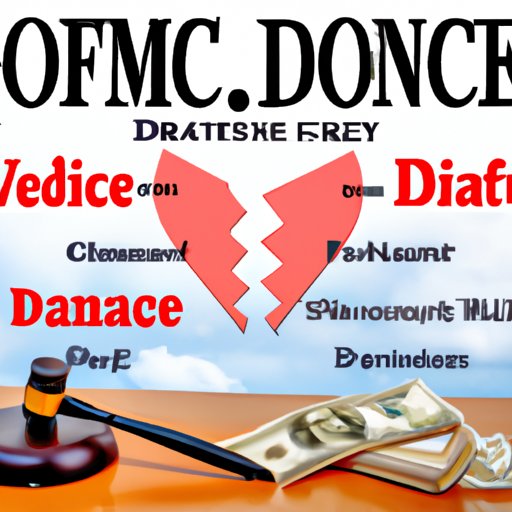Introduction
Divorce is the termination of a marriage by a legal process that involves both spouses. It dissolves their legal marital union, allowing them to remarry or enter into other relationships. The process of divorce is often difficult and emotionally draining, but it also has significant financial consequences.
The financial cost of divorce can vary widely depending on the complexity of the situation. Generally, there are three main areas where costs arise: court and legal fees, child support and alimony payments, and division of marital assets.

A Comprehensive Look at the Financial Cost of Divorce
The first area of expense associated with divorce is court and legal fees. Depending on the laws in the state in which you are filing for divorce, court fees can range from a few hundred to several thousand dollars. In addition to these fees, each spouse typically incurs legal fees for their own representation, which can add up quickly. According to a survey by the American Academy of Matrimonial Lawyers, the average cost of a contested divorce is $15,000 per person.
Child support and alimony payments may also be part of the financial cost of divorce. These payments are determined based on the income of each spouse and the number of children involved. They are typically paid until the children reach adulthood, although in some cases they may continue beyond that point. Child support payments can range from a few hundred dollars to thousands of dollars per month, depending on the circumstances.
The third major expense associated with divorce is the division of marital assets. This includes any property, investments, or other assets that were acquired during the marriage. Each spouse is typically entitled to half of these assets, although the exact division may vary depending on the laws of the state and the agreement between the two spouses. This process can be complicated and costly, as it requires the help of professionals such as lawyers and accountants.

How to Budget for a Divorce
When it comes to budgeting for a divorce, the best course of action is to estimate the cost of a divorce before beginning the process. This will allow you to plan ahead and set aside money for the various expenses associated with the divorce. It’s important to remember that the cost of a divorce can vary significantly depending on the complexity of the situation, so it’s best to overestimate rather than underestimate.
In addition to setting aside money for a divorce, it may also be helpful to seek financial help from family and friends. This can include loans or other forms of assistance to help cover the cost of the divorce. It’s important to remember, however, that any loans should be repaid in full once the divorce is finalized.
Unanticipated Costs of Divorce
In addition to the expected costs associated with divorce, there are also a number of unanticipated costs. Moving expenses, for example, can add up quickly if one spouse needs to relocate after the divorce. Similarly, the loss of income due to one spouse no longer being employed can have a significant financial impact. Health insurance is another potential expense, as many spouses are covered by their partner’s health insurance plan and must purchase their own coverage after the divorce.
Navigating Divorce as a Couple: What It Costs
When it comes to navigating a divorce as a couple, there are a few different options available. Mediation and counseling are two popular choices, as they allow the couple to work together to resolve their differences in an amicable manner. Collaborative divorce is another option, which involves both parties working with lawyers, financial advisors, and other professionals to come to an agreement. Litigation is the most expensive option, as it involves taking the case to court and having a judge make decisions about the terms of the divorce.

The Impact of Divorce on Your Finances
Divorce can also have a significant impact on your finances. One of the biggest changes is to your credit score, as it can take years for your score to recover from the financial stress of a divorce. Additionally, there may be tax implications, as filing taxes separately after a divorce can increase your overall tax burden. Finally, it’s important to re-establish your financial security after a divorce. This may involve rebuilding your credit, investing in retirement accounts, and creating a budget to ensure you’re able to meet your financial obligations.
Planning Ahead: Understanding the Cost of Divorce Beforehand
It’s important to understand the cost of divorce before beginning the process. Talking to a financial advisor can be helpful in estimating the potential cost of a divorce and planning for the future. Additionally, researching the divorce process in your state can provide valuable information about the various costs associated with divorce. Finally, it’s important to evaluate all of the different options available, as each has its own advantages and disadvantages.
Conclusion
Divorce is a difficult process, both emotionally and financially. It’s important to understand the various financial costs associated with divorce, from court and legal fees to division of assets. Additionally, it’s important to budget for a divorce and anticipate any unanticipated costs. Finally, it’s important to understand the impact of divorce on your finances, as well as ways to plan ahead for the future.
(Note: Is this article not meeting your expectations? Do you have knowledge or insights to share? Unlock new opportunities and expand your reach by joining our authors team. Click Registration to join us and share your expertise with our readers.)
